Composer Johan Franco
A Conversation with Bruce
Duffie
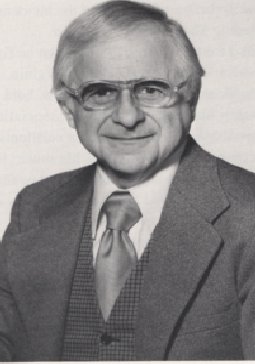
Composer Johan Franco
A Conversation with Bruce
Duffie

When I was growing up in Evanston, Illinois, my parents took me to St. Mark's Episcopal Church on Ridge Avenue, specifically, as my mother later told me, because they had outstanding music. As a member of their Choristers - a professional men and boy's choir of the English tradition - I got my earliest musical training. Some of the boys got awards for perfect attendance, but I received one of the very rare medals for singing! The church also had a nine-bell carillon, and, as a teenager, I played it each Sunday for a year and a half. About twenty minutes before the 11 AM service, arrangements of hymns and carols made up the programs, and occasionally I'd improvise some 'changes.' It never occurred to me that someone might actually write music specifically for the instrument. Many years later, when I was working at WNIB, I stumbled on a recording of a work for carillon, and knew immediately that I had to add that composer to my list of interview guests.
Johan Franco was born in Zaandam, Holland, on July 12, 1908, and studied composition, harmony, counterpoint and orchestration with the foremost Dutch composer and pedagogue, Willem Pijper (1894-1947). Following the successful premiere of his first symphony by the Rotterdam Philharmonic in 1934, Franco came to the US, served in the U.S. Armed Forces during World War II, and became an American citizen in 1942. He later lived in Virginia Beach, Virginia. His major works include five symphonies, a Violin concerto, a Christmas Oratorio and an Easter Cantata, as well as five string quartets and other chamber works, plus music for carillon, which he called, "One of my favorite hobbies." He married Eloise Bauder Lavrischeff in 1948, and many of his works are based on her texts. He was a charter member and treasurer of Southeastern Composers League; a member of Broadcast Music, Inc.; American Composers Alliance; Guilde des Carillonneurs de France; and an associate member of Guild of Carillonneurs in North America. The composer lived until April 14, 1988.
The Johan Franco Collection at Old Dominion University in Norfolk, Virginia, contains just over 150 scores spanning the six decades of the 1930s through the 1980s. It also contains some biographical material, programs, and reviews. A larger collection of Franco's material is housed in the Moldenhauer Archives at Northwestern University in Evanston, Illinois.
Franco was one of a number of BMI composers that I was able to track
down, and in February of 1987 we arranged for a telephone chat. He
sent me some of his commercial recordings, both widely-distributed and very
small issues, as well as a few non-commercial items so that I could become
familiar with a variety of his creations. After exchanging the usual
pleasantries, he wanted first to talk about something very close to his heart...
Johan Franco: It's a book for children that my wife and I have written together, and it's called Making Music.
Bruce Duffie: What age level is this designed for?
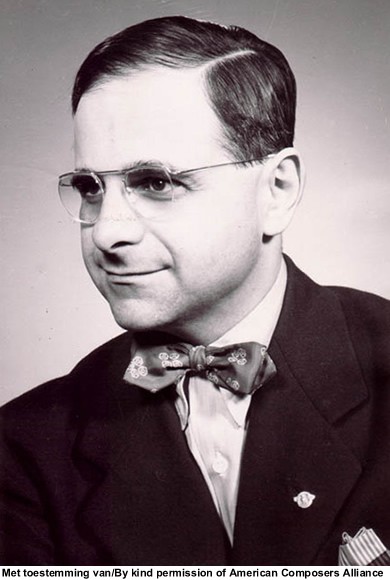 JF: Oh, any age. I would say up to twelve, thirteen, or so.
JF: Oh, any age. I would say up to twelve, thirteen, or so.
BD: Tell me a little bit about the book.
JF: Well, let me read you from the brochure: "Music grows. I let my music grow for me." That's one of the little poems that my wife wrote, and I put in the book. "Yes, indeed, music grows. Every inspiration, whether for making music or for any other artistic endeavor, comes from within, and grows into outer expression. Sometimes, this takes place at once, after an original idea is conceived. But most of the time it takes patient waiting for the idea to come to fruition. This patient waiting wanting to make music, we have set forth as a magic formula: think, want, wait. In each of the eleven projects, all with musical examples, we suggest a subject, telling the child to be on the lookout for an idea that may turn into a little original song. After he has an idea of what the song may be about, he applies the magic formula, and so is actually becoming trained in the conscious use of inspiration."
BD: That's very nice. And then the book has these eleven projects?
JF: Yeah! My wife wrote a book, and all I did was set these little verses to music. I always work that way. I don't write anything that isn't inspired, I would say. I believe in inspiration first. That's the most important thing. I don't go for that theory that you should be able to get up in the morning and then start writing, no matter what.
BD: You wait for the muse to hit you?
JF: Yes. Yes, that's an old-fashioned idea, maybe, but it is how I work.
BD: What part does technique play in the business of getting the music down?
JF: Well, the children wouldn't know how to write it down. They need the help of their elders, or the teacher, or somebody, to write down what they come up with.
BD: But what about when you are writing your own music?
JF: Oh, well, I know how to write it down. So that is no problem.
BD: Pursuing this business of children and the educational process just a little bit more, in viewing the widespread proliferation of recordings that have been foisted on the public, do you feel that this is a good thing for children, or is it too much for them?
JF: Oh, I think they are overloaded with recordings, and most of it is worthless. It's too complicated, to begin with. I go for the very, very simple. I would like them to be able to throw away all that complication that's in the stuff that they hear all over the place. Don't you agree?
BD: Well, yes, I think so. I'm also interested in how you feel the children are influenced by rock and roll...
JF: Whoah, let's not talk about that, because I think that's just deadly.
BD: Then how can we get more kids more interested in concert music?
JF: Well, it's not necessarily (just) concert music. I think that the ballet, for instance, has done a great deal of good, because there they see that serious music can be expressed by dancing. I think that's an opening towards good music. Don't you think so?
BD: Sure. Sure. Anything that would get them into one or another of the serious arts, that's always a good thing.
* * * * *
JF: I sent you some recordings of my music. On one tape, I played Initiation and Dance. There is no connection between the two. The Initiation was written in 1947, and the Dance is the last movement of Partita #1, which was written in 1941. I played those two together, sometimes, but in that recording that I sent you, they were parts of different recordings.
BD: These are the ones that you feel are most representative of your work?
JF: Well, the Initiation piece, yes, I think so. That was when I had just met my wife, and I was very much in love with her. That piece is sort of an initiation into a new phase of my life. I don't think that anybody besides myself has ever played that piece. That recording was made in Times Hall in New York. It doesn't exist anymore. It became a recording studio, and I think Merv Griffin had it for a while.
BD: [Chuckles, amused and surprised]
JF: That concert was recorded by WNYC-FM. It was
live, and then it was rebroadcast, so what you have there is my playing at
that occasion, and that makes it interesting But I have just begun to
revive that piece; I want somebody else to play it. There is a pianist
in New York named Max Lifchitz. [See my interview with Max Lifchitz.]
He is a very fine musician, and he wants to do some of my music on
a recording. I want him to play that piece, and some others...
Possibly the Twelve Preludes (1975), or something else. I don't
know yet. [Lifchitz, so far, has recorded Redemptions Triptych
on a N/S CD, and conducted another Franco piece noted later in this interview.]
BD: You are the performer on several of these things on the tape. Do you feel that you are the ideal interpreter of your works?
JF: Not always, no. Some of them are technically too complicated. The Theme and Variations (1944) that William Masselos played, I couldn't play them with the speed and the abandon he did. So his performance is certainly preferable to mine. And the Twelve Preludes, I've never been able to play all of them. The recording you have there is done by George Bennette, who is the head of the Lighthouse Music School for the blind. He's blind himself, and learned the score from a braille copy. His secretary made him a braille copy of the manuscript.
BD: I would think that would be terribly tedious.
JF: I know, and it is fantastic the way he does it, and the way he performed it without my coaching him, or anything. I didn't even see him between the time I sent it to him and the time he sent me the tape.
BD: You say, "without my coaching." Do you very often advise performers on how to perform your music?
JF: No. No. Last November I was in New York, and they were doing the Songs of the Spirit (1959). You have a tape recording of it done by Jan DeGaetani, with me at the piano. It was a beautiful performance in Carnegie Recital Hall. But the newer performance is the original version for soprano and woodwind quintet! That was done by Danielle Woerner, and I went there for a rehearsal, but there was nothing I could say. It was just a superb performance. [This was recorded by Woerner and an ensemble conducted by Max Lifchitz on the Classic Masters CD shown above.]
BD: Have you basically been pleased with all the performances you have heard of your music over the years?
JF: [Without hesitation] Oh, no. [Laughs] No! I've had the craziest things happen. I had a performance in Carnegie Hall of my Third Symphony [subtitled "Symphony Concertante"] where the brass were supposed to use C trumpets, but they didn't look in the score, and they didn't look in the part, and they used B-flat instruments.
BD: So they were a whole tone off through the entire thing???
JF: A whole tone off through the whole piece, and they didn't know what hit them. I knew what hit me, and it was just awful. I told the conductor, "I think we should do it over, don't you think?" And he never replied. I won't mention his name, but I'm sure you know of him. That was in 1945 or so...
BD: I asked about performances, so, let me ask about the recordings. Are you basically pleased with those?
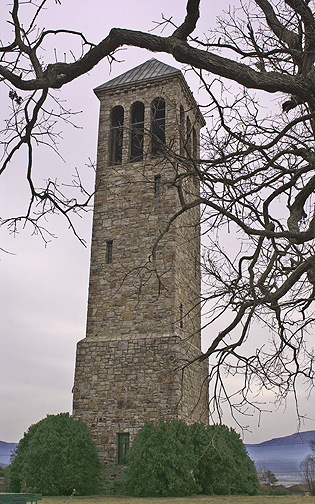 JF: Oh, yeah. Well, those I supervised. The recording
of the cantata, As the Prophets Foretold [a Cantata for Easter, for
solo tenor, solo bass, chorus, 3 trumpets, 2 trombones, and carillon (1955)
on CRI], of course, is an approximate effect, because we couldn't have a
live performance of the carillon. The carillon was dubbed into the
indoor performance of it at The New York Avenue Presbyterian Church in Washington,
D.C. Steve Prussing conducted the performance, and he had the
choir, soloists, and brass all well rehearsed. And the recording on
tape of the carillon [made at the Luray Singing Tower in Luray, Virginia]
was played by Charles T. Chapman, and he did a splendid job. It was
very difficult to get the two together.
JF: Oh, yeah. Well, those I supervised. The recording
of the cantata, As the Prophets Foretold [a Cantata for Easter, for
solo tenor, solo bass, chorus, 3 trumpets, 2 trombones, and carillon (1955)
on CRI], of course, is an approximate effect, because we couldn't have a
live performance of the carillon. The carillon was dubbed into the
indoor performance of it at The New York Avenue Presbyterian Church in Washington,
D.C. Steve Prussing conducted the performance, and he had the
choir, soloists, and brass all well rehearsed. And the recording on
tape of the carillon [made at the Luray Singing Tower in Luray, Virginia]
was played by Charles T. Chapman, and he did a splendid job. It was
very difficult to get the two together.
[Photo at right: Luray Singing Tower]
BD: I would think coordinating it would be very difficult.
JF: Yes, it was, but they did very well. There were a few spots where it isn't quite right, but I'm still hoping someday to hear a live performance. I was promised one in France, and I had the text translated by an expert in a metrical French translation, so nothing had to be changed in the music. I gave that score, with the French translation, to a conductor in 1972, but he hasn't done it yet. He tells me he wants to do it, but maybe I should give up now. I don't think it will get done. [Chuckles]
BD: Why the big interest in such a seemingly unwieldy instrument?
JF: I was born in Holland where there are lots of carillons. They were all out of tune when I lived there, but after the War, they practically revived the carillons. They put new bells in them, and tuned some of the old bells, and put some of the historical bells in museums. So now the carillons are really first-rate again, and I'm sure I would like 'em now. But when I lived there I didn't care at all for carillons. Then one day I came here in Luray, and I listened to the carillon there, and Charles Chapman played some of my pieces on it. This was in the middle '50s, and I was absolutely overwhelmed by it. It was so beautifully done, and they were so well tuned. These bells were superb. They were made in England. Taylor Bells from the Taylor Foundry in Loughborough, England. There's several carillons made by them in this country. One is the Bok Singing Tower in Lake Wales, Florida, where they recorded my Seven Biblical Sketches for carillon and narrator. I stayed there for a whole week. Milford Myhre played it every night, and we recorded it every night, and it wasn't still enough until finally, about four or five days after I got there, we had an absolutely still night, and the only sound you hear in the recording besides the bells are the crickets. Did you notice that?
BD: Yes, I noticed that at the very beginning, where it was soft.
JF: Well, everywhere where it's soft you hear the crickets, and that's wonderful. I think that it gives it a natural feeling. It could have also been bullfrogs, you know. They have those too, but we were lucky we didn't get those.
BD: Is the carillon itself situated far enough away from
roads and airplanes?
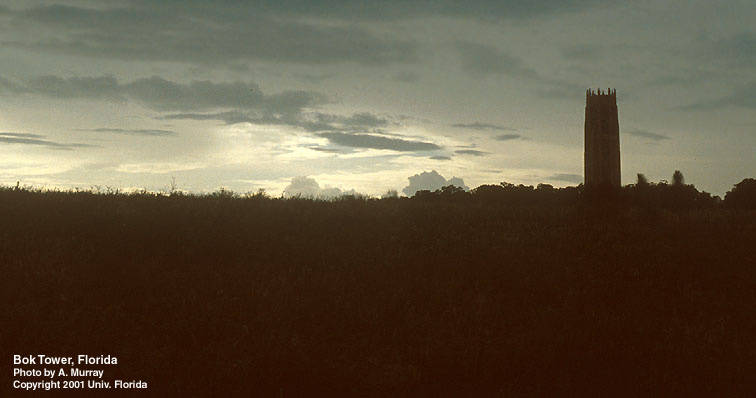
JF: Yeah. It's in the mountain lake sanctuary. It's
a bird sanctuary, and it's a beautiful nature park. It's only approached
from way outside roads that lead into it. So it's way away from the
road. The only thing is that sometimes airplanes come over it.
They're not supposed to, but they do.
BD: I would think it would be terribly difficult to write for a carillon, because each instrument is so different and unique.
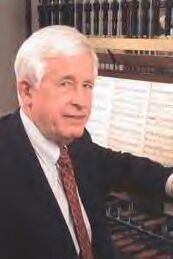 JF: It is. They're all different. The one in Duke
University used to be played by Anton Brees, who was also the carilloneur
of the Bok Tower that Myhre [photo
at left] played on my record. When I first
visited him, he said, "Why don't you study with me? I won't charge
you, and you can study with me." I said, "Oh, no. I'm much too
old to start learning a new instrument. I am only interested in writing
for it." I don't have to play it myself, and go through the acrobatics
that carilloneurs have to go through, because it is really quite a heavy
job!. [Both chuckle knowingly] Even if the bells are on keyboards,
and connected with the keyboard, between the bell and the keyboard are very
fine balanced wires that have all kinds of counterweights and everything,
that makes it easier to play. But still it's quite complicated, and
also you have the pedals. I cannot play the organ, so I wouldn't be
anything near where the carilloneurs who have started from the beginning
would be.
JF: It is. They're all different. The one in Duke
University used to be played by Anton Brees, who was also the carilloneur
of the Bok Tower that Myhre [photo
at left] played on my record. When I first
visited him, he said, "Why don't you study with me? I won't charge
you, and you can study with me." I said, "Oh, no. I'm much too
old to start learning a new instrument. I am only interested in writing
for it." I don't have to play it myself, and go through the acrobatics
that carilloneurs have to go through, because it is really quite a heavy
job!. [Both chuckle knowingly] Even if the bells are on keyboards,
and connected with the keyboard, between the bell and the keyboard are very
fine balanced wires that have all kinds of counterweights and everything,
that makes it easier to play. But still it's quite complicated, and
also you have the pedals. I cannot play the organ, so I wouldn't be
anything near where the carilloneurs who have started from the beginning
would be.
BD: But each piece you write, then, has to be written for a specific instrument.
JF: No! No, because they are more or less alike. And about the keyboards, they have had all kinds of conferences to design ideal keyboards. Most of the new carillons now have that same keyboard, and some of the big old carillons are getting new keyboards, so they can be played by experts. But there are not that many very fine carilloneurs. There is a guild of carilloneurs in North America, and some of the members are really outstanding.
BD: Are you really the only one who is writing, specifically, new music for the carillon?
JF: No. No, no. There are others, but it seems that I have written more. The quantity isn't necessarily indicative of the quality. There are some very fine people like Roy Johnson of the University of Maryland. He teaches piano, and he's a very fine musician, and he writes for the carillon very, very well. His famous piece is the Summer Fanfares . I don't know if you've heard that. It's a fantastic piece. I first heard it in 1956 when it was brand new then. It kind of bowled everybody over, but me in particular. [Chuckles] I would say I'm very impressed by it, and that's his masterpiece. He's written a lot of other pieces since then, but none of them as extraordinary as that one.
BD: I assume that it is more difficult to organize a carillon concert than it would be to organize a string quartet concert.
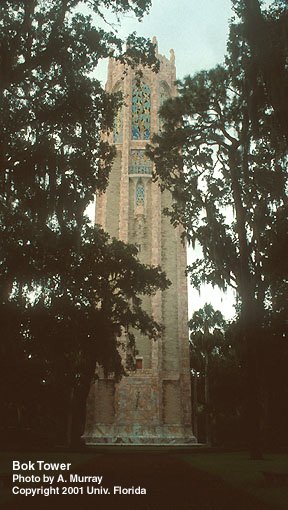 JF: Well, I don't know. Why it would be? In Luray
they have one every three or four days, and in Lake Wales they have one every
day. Some of them are recorded, and they play the recordings of previous
recitals. They have such an ideal system of reproduction that you can't
even tell if it's a live performance or a recorded one. Only if you're
an expert can you tell the difference. Myhre plays on Saturday and
Sunday, and Tuesday and Thursday, and so, on. But every day they have
recitals, and every hour on the hour they have about a five minute sample
of what it sounds like. That's the way they do it there, but of course,
they have a lot of money to back it up. Edward Bok, who built the tower
in 1929, had President Coolidge to come down to dedicate it. Fifty years
later, in '79, we had a celebration. It was so cold that we were all
huddled under blankets, sittin' out there to listen to it.
JF: Well, I don't know. Why it would be? In Luray
they have one every three or four days, and in Lake Wales they have one every
day. Some of them are recorded, and they play the recordings of previous
recitals. They have such an ideal system of reproduction that you can't
even tell if it's a live performance or a recorded one. Only if you're
an expert can you tell the difference. Myhre plays on Saturday and
Sunday, and Tuesday and Thursday, and so, on. But every day they have
recitals, and every hour on the hour they have about a five minute sample
of what it sounds like. That's the way they do it there, but of course,
they have a lot of money to back it up. Edward Bok, who built the tower
in 1929, had President Coolidge to come down to dedicate it. Fifty years
later, in '79, we had a celebration. It was so cold that we were all
huddled under blankets, sittin' out there to listen to it.
BD: Is it satisfying to you to write for the carillon?
JF: [Without hesitation] Yeah. Very much so. What I like so much is the sounding out of sounds that you cannot stop. You know, there are no pedals like on the piano that let you muffle the sound. You cannot. Once it's struck, it sounds, and it stays sounding until it's finished. That gives, sometimes, very unusual combinations of sound.
BD: When you're writing for the carillon, do you take this physical property into account?
JF: Yes, of course. You have to. That's why 12-tone music doesn't sound too happy on it. [Chuckles] Somebody sent me an arrangement he made of a children's piece that Anton von Webern wrote originally for the piano. He made a carillon piece out of it, [Laughs] but I don't see how it can possibly sound very happy.
BD: Should music always sound happy?
JF: No! No. Some of it is fantastic, like Lazarus in the Seven Biblical Sketches. [Written between early February of 1977 and late March of 1978, the movements are: Green Pastures; Thou Shalt Call His Name; When the Wise Men Came; The Woman at the Well; The Miracle of the Loaves & Fishes; Lazarus; The Third Day.]
BD: Then what do you feel is the ultimate purpose of music?
JF: Well, it's just a reflection of the soul. There's no "purpose." I really wouldn't know how to answer that question.
* * * * *
BD: You are a composer. Are you also a teacher of music?
JF: [Without hesitation] No. I've taught piano, but no, never. I studied privately with two people. One was Willem Pijper, and with Bertus Van Lier (1906-1972) who was a very dear friend of mine. He lived next door and I had some lessons with him in the '30s. When he died, I wrote a piece in his memory called Le Tombeau de Bertus Van Lier that's still played on occasion.
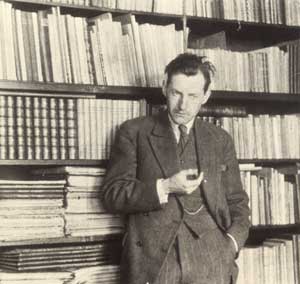 BD: What did you learn from Willem Pijper? [Photo at right]
BD: What did you learn from Willem Pijper? [Photo at right]
JF: Oh, everything, including orchestration and harmony. I had my whole musical education from him, more or less.
BD: Did you purposely stay away from teaching yourself?
JF: I was lucky, I didn't have to teach. I did teach some piano, but not much.
BD: Is musical composition something that can be taught, or must it be just innate from each person?
JF: Yeah, it must. That was what I liked about
Pijper, because none of his pupils wrote music that sounds the least bit
like his, or like each other. Each has become his own writer, and his
own creator. And he was such a good teacher that even when I didn't
like his music anymore, he was still a very wonderful teacher to me.
His Symphony #3 is quite a stunning piece, but then he has a piano
concerto that's raved about, but I don't think it's a very good piece at
all.
BD: Who are the contemporary Dutch composers that you admire?
JF: I can't tell you one single name. I know a few names, but I haven't heard their music. I am not up to date with that at all. I haven't been able to hear anything, and I haven't been in Holland for a long, long time. I've been in France and England, but when I go there, I don't go for the music. I go for other things, like architecture. I studied architecture, too. I don't know if you know that.
BD: No, I was unaware of that.
JF: Yeah. My father was an architect, and I studied architecture. I built some houses, and I designed some furniture, and all kinds of things like that in Holland.
BD: You should design a music studio.
JF: [Laughs] Like Pierre Boulez? I've seen that.
BD: Do you approve of the many directions that music is going today?
JF: Oh it's hard to say. I don't approve of the minimal music. It's total nonsense.
BD: Why?
JF: [Laughs] Music is so complicated that there is absolutely no direct road to making it so boring and simple that it keeps repeating itself. And Stravinsky is another instance. I liked his work up to 1918, and after that he went down, down, down. [Laughs] And he's still going down. They play those later works much too much, in my estimation. Do you know Ben Weber (1916-1979), the composer?
BD: I never met him, but I know of him and his music.
JF: He died a few years ago, and I asked him once about that Symphony in C of Stravinsky [1939-40]. He said, "Ooh, it's very good to do calisthenics by." [Both laugh] Which is kind of devastating, isn't it?
BD: Well, what of the new music do you approve of, if any?
JF: If any? Oh, [Thinks for a moment] I
do like some of the Crumb things, especially that one with the children.
[Franco may be referring to George Crumb's Star-Child (1977/79).]
I saw that done beautifully in Paris. [See my interview with George Crumb.]
* * * * *
BD: Let us come back to some of your other works. Tell me about your cantata As the Prophets Foretold.
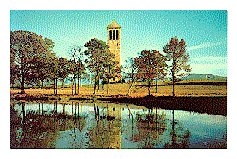 [Photo at right:
Luray Singing Tower]
[Photo at right:
Luray Singing Tower]
JF: My wife wrote the text, and that is the story of our meeting. It began in 1947. No, it began much earlier than that. She had written an Easter cantata, and she used Russian melodies because her first husband was a Russian, and a professor. They lived in Alaska. She had all this all written out and everything, and she wanted to get somebody's opinion. She asked a mutual friend of ours who she could send this to, and this friend suggested me. So she wrote me a letter and said, "May I show you this?" She lived in Washington at the time and her husband had died. She worked for the government and I told her I was going to come to Washington and give a talk about the Comte de Saint-Germain. I don't know if you ever heard of him. But I was very much interested in this mystery man. He was an alchemist, and a miracle man in many ways. He also composed music, and I had done some research on him, and wrote an article for the The Musical Quarterly about it. [Franco, Johan. "The Count of St. Germain." The Musical Quarterly, vol. 36, no. 4 (October 1950), pp. 540-550.] She said okay, we're going to meet at the home of friend of hers who was also from France. She wanted to give it to me right then, but I couldn't take it with me because I was traveling, so I asked her to send it to me in New York. So she did, and I didn't know what to say because I didn't like the music, but I liked the text, and I liked her! I wrote her back in a very diplomatic way, and we kept in contact for a long time. Then we got engaged, and got married in 1948. We moved down to Virginia Beach, and she became editor here at the Cayce Foundation for a magazine that they were putting out called The Searchlight. Then, seven years later, she found cantata again, and rewrote the text and set it on the piano without saying a word to me. I saw it, and I started writing the music for it. And I wrote it straight through without stopping. There were no complications writing it. I was really inspired to do it. Then I showed it to the Luray carilloneur, Charles Chapman, and he said he knew just the man who would do it, in Washington. That's how Steve Prussing came to conduct the music. They tried it first with organ, and then we did it with the carillon dubbed in. It was recorded by CRI, and so that's our love story. It's probably the most important thing I ever did.
BD: You mentioned that when you composed As the Prophets Foretold, you just wrote it out without any changes.
JF: I very rarely change things into my scores. Once I write something down it will stay.
BD: I was going to ask if you ever make any revisions at all.
JF: I have done a few because of technical difficulty. For instance, the Douai Nocturne [1973-81], I found out later that it was practically unplayable the way I had written it. So I had to rewrite it and simplify it. I've done that in a very few pieces.
BD: Would you be pleased if someone eventually could play the original version?
JF: No. No, the new version takes the place of
the original. For sure.
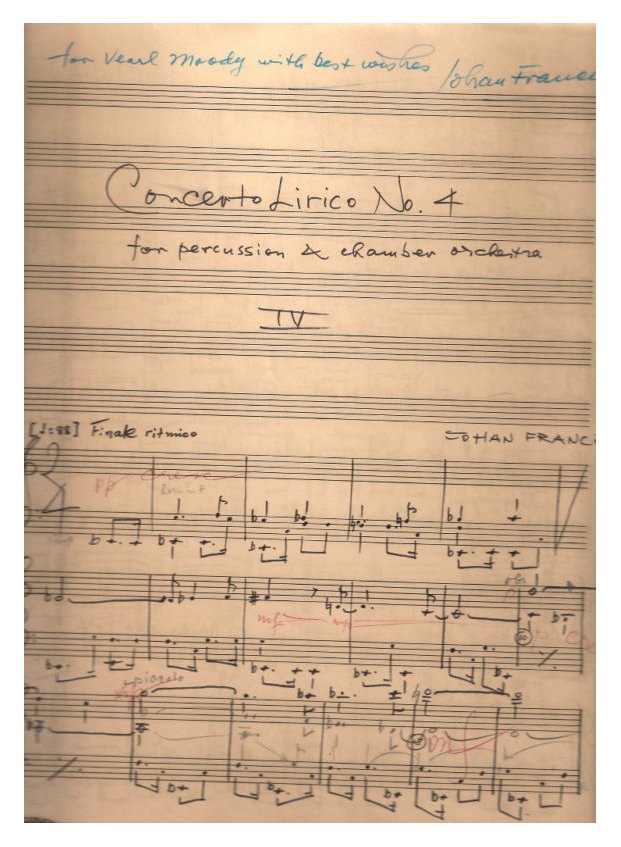
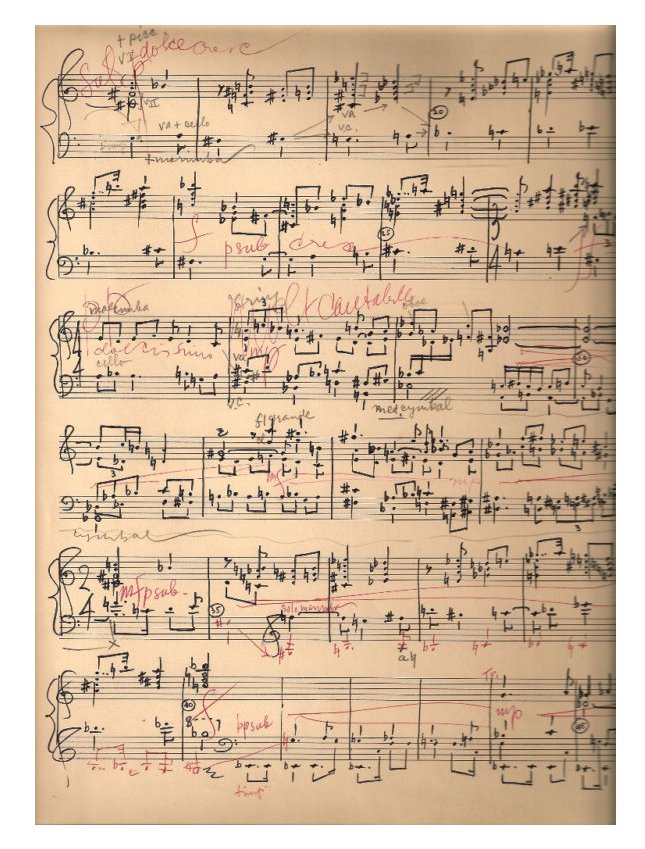
BD: You also sent me the incidental music for the productions by the Everyman Players.
JF: Yeah. Those are only fragments, because some of the recordings I have of them are not good enough for a recording, not good enough for a disc. For instance, of The Pilgrim's Progress, there is so much there that is all orchestral, but some of it is not good enough to be on a disc. Other things, like the final scene is what they call aleatoric. There is one channel that has the carillon sounds, the very heavy bell sounds of the celestial city, and Orlin Cory, the Producer and Director of the Everyman Players, insisted on harp sounds. I said, "That's ridiculous. How can you have a harp compete with a carillon?" And he said, "Well, that's a matter of miking, you know, if you bring up the miked sound." So we have a channel of miked of harp that is way up, and you hear it right through the carillon.
BD: But then you have, actually, the producer trying to make musical decisions.
JF: Yeah, but under my control. I was there when it was done, so I could direct it. [Chuckles] It was done in Jacksonville by William Hoskins (1917-1997), who was, at that time, professor of music at Jacksonville University. He has the most elaborate synthesizer equipment that you have ever seen or heard, and he's done things for me that are unbelievable. Like the birds in Electra, and the storm in The Tempest. You've heard that?
BD: Yes, I was listening those. They are fascinating.
JF: Yeah, it is fascinating. If you could have seen how he did it, it's just unbelievable. Hours and hours of painstaking work. But it pays off. It's beautifully done.
BD: So you approve, then, of using electronics in along with your music.
JF: Yes. In certain ways, yes, and especially for theatrical things. I've done two major works. One is for saxophone and electronic synthesizer, and the other is a piece for flute and synthesizer that won a prize here in Virginia, and was performed at the University of Virginia. A friend of mine, the flutist, was playing, and I played the tape recorder. The tape of the synthesizer was on my tape recorder, and we played that against the flute, but I could regulate the volume.
BD: So you had some control over it.
JF: Oh, yeah. And in the saxophone piece, too, is written like instruments. The synthesizer played like instruments, definite pitches. Not just sounds, but actual pitches and harmonies, and rhythms. Everything. It could be written out and performed by traditional instruments.
* * * * *
BD: Tell me about the recording of the Symphony #5.
JF: That was in Haarlem, in Holland, and that was a rather
good performance. Of course, it's so long ago they would do a much better
job on it now. But for then it was pretty good. It was in '58.
On another CRI record is The Virgin Queen's Dream Monologue for dramatic
soprano and orchestra. That is a Baconian thing, as you can read on
the jacket...
| The Aria, The Virgin Queen's Dream Monologue, is the only existing portion of a planned opera about Sir Francis Bacon. The subject was of special interest to Franco, a convinced Baconian, who has found time when not composing to publish various pamphlets pertaining to the Bacon-Shakespeare controversy. The Aria was composed in 1947, and orchestrated in 1952. It had its first performance the following year at the University of Alabama's Composers Forum. The text is taken from the Tragical Historie of our Late Brother, Earl of Essex, and construed by the late Dr. Orville Owen from Shakespearean texts by means of his "wheel-cipher," an apparatus constructed for the purpose of discovering hidden plays within the Shakespearean plays. The Aria depicts a nightmare of Queen Elizabeth I who, according to the Baconian conception revealed by this cipher, was secretly married to the Earl of Leicester, and the mother of Sir Francis Bacon and the Earl of Essex. From the notes on the
back of the jacket for CRI-124,
an LP record which also states, "Hi-Fi Recording"! |
...The other piece that's on there I don't like at all anymore. [Fantasy
for Cello and Orchestra (1951)]
BD: Why don't you like it?
JF: I just don't like it; don't play that.
BD: Okay. I won't play it, then. [Laughs] There's so much material, we might as well not play things that you don't care for.
JF: That's the only piece that's on a recording of mine that I don't like. [Wistfully] I don't know why.
* * * * *
BD: You've been involved in several theatrical productions. Have you written any operas?
JF: [Emphatically and without hesitation] No.
BD: Why not?
JF: I was going to write an opera about Francis Bacon, and that Dream Monologue is the only thing that exists like that. I couldn't find anybody to write the libretto. I've tried to find somebody, but I never was able to.
BD: Of the works that you have written, have these been commissions, or are they works that you just feel you had to write?
JF: The theatrical things were all commissioned by the Everyman Players. They commissioned five productions, and they're all represented on that record you have. The first one was Romans by Saint Paul, and it was my idea to use the carillon. They were absolutely overwhelmed by the idea. When I let them hear what I had in mind, they loved it. We had performances all over the place, including one in New York, at Saint Thomas Church, an Episcopal church at Fifth Avenue and 53rd Street in Manhattan. And it was broadcast by CBS Television. Do you remember the program Lamp Unto My Feet? They did it one Sunday. Unfortunately it wasn't in color yet, just black and white. And the piece was done again later on, including here in Norfolk, Virginia. And we took it to Europe, in old cathedrals in England. It was done in the Royal Chapel under St. Paul's Cathedral in London. There, nobody is allowed to step on the carpet in front of the altar except the Queen, so St. Paul was not allowed to retreat, and walk backwards towards the altar as he usually does. They wouldn't let him step on the carpet. [Chuckles] And we did it in Westminster Cathedral, a Catholic cathedral also in London. The Book of Job was done in St. Paul's Cathedral, and in Bury St. Edmunds, and various other places including Liverpool, which was a very modern cathedral. [Liverpool Cathedral, an Anglican cathedral begun in 1904 and completed in 1978.] And, let's see, where else? Oh, yes, in the cathedral that is right next to where the Globe Theater of Shakespeare used to stand, on the other side of the Thames, opposite the Tower of London. [This is almost undoubtedly the Southwark Cathedral, an Anglican Cathedral in Southwark, London.] And they did it in an old cathedral from the 11th century. It was beautiful!
BD: It sounds like you had a great deal of fun watching your productions travel.
JF: Yeah. And those performances were definitely different everywhere they were done. They had to be done in different ways, because of the space available. We couldn't change the space. Very interesting.
* * * * *
BD: I assume that you are still writing?
JF: Yeah, I'm still writing. The last piece I just finished is a piece about the wind, for carillon, of course. Lullaby of the Wind (1985).
BD: When you're working on a piece of music, do you work on just one piece at a time?
JF: [Without hesitation] Oh, yeah!
BD: You don't have several going at once?
JF: [As if such a thought were out of the question] No. [Chuckles] No, I think that's folly. Folly. I couldn't possibly do that.
BD: When you're writing the one piece of music, how do you know when it's finished?
JF: That's a good question. Or how do you know that it is not finished. That's even harder, sometimes. I think it's finished, and then the next morning I get up and I play through it, and I say, "No, it isn't finished." [Chuckles] That happens, and I add a few measures.
BD: There must come a time in each piece that you say, "I must stop tinkering with it."
JF: [Chuckles] Well, it's not so much tinkering, but it is that the form is there, and that you can't fill it up any further and that the thought of it is worked out.
BD: I want to thank you very much. It's been delightful speaking with you this afternoon. I've learned a great deal about you, and about your music.
JF: Well, I don't know; I feel kind of inadequate. I told you in advance that I was worried about that, and I'm still worried. I don't know know how much I said was eloquent. But it was wonderful talking with you.
BD: Oh, it's all come across very well. The programs will go just fine, I'm sure.
JF: Well, I wish you lots o' luck! I certainly
appreciate it. You're doing a fantastic job.
=== === === === ===
--- --- ---
=== === === === ===
© 1987 Bruce Duffie
This conversation was recorded on the telephone on February 21, 1987,
and portions were broadcast (along with some of his music) on WNIB in 1988,
1993 and 1998. A copy of the unedited audio was placed in the Archive
of Contemporary Music at Northwestern University. This transcription
was made early in 2007, and posted on this website at that time.
To see a full list (with links) of interviews which have been transcribed and posted on this website, click here.
Award - winning broadcaster Bruce Duffie was with WNIB, Classical 97 in Chicago from 1975 until its final moment as a classical station in February of 2001. His interviews have also appeared in various magazines and journals since 1980, and he now continues his broadcast series on WNUR-FM.
You are invited to visit his website for more information about his work, including selected transcripts of other interviews, plus a full list of his guests. He would also like to call your attention to the photos and information about his grandfather, who was a pioneer in the automotive field more than a century ago. You may also send him E-Mail with comments, questions and suggestions.